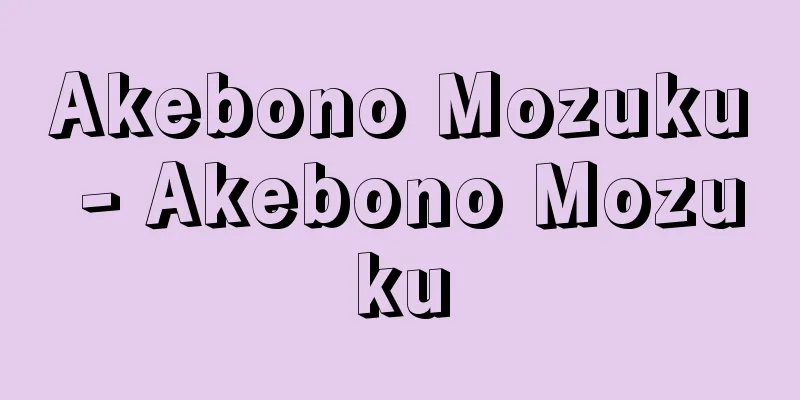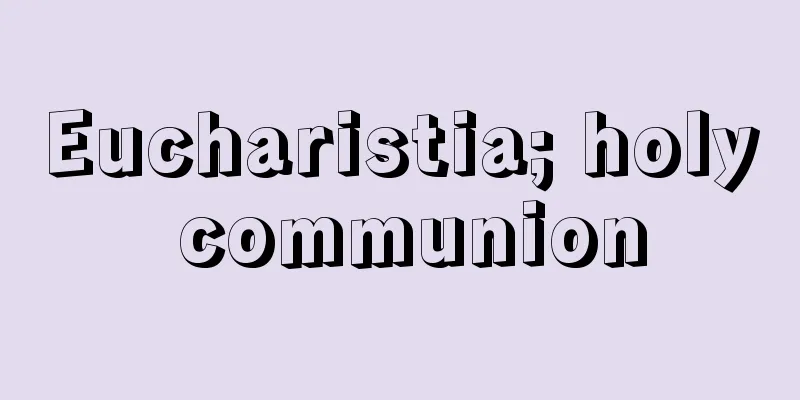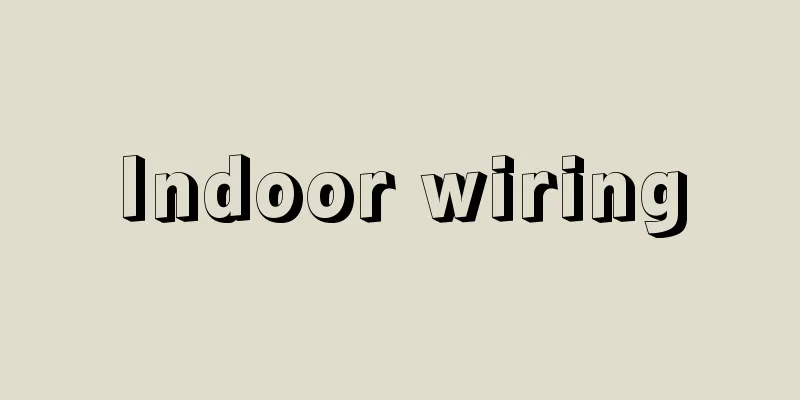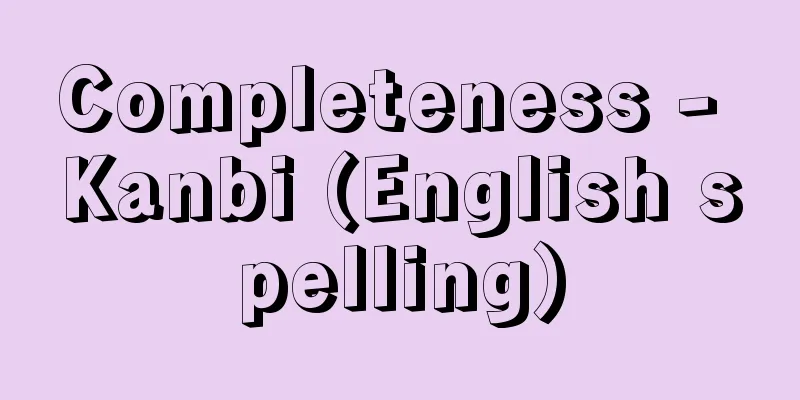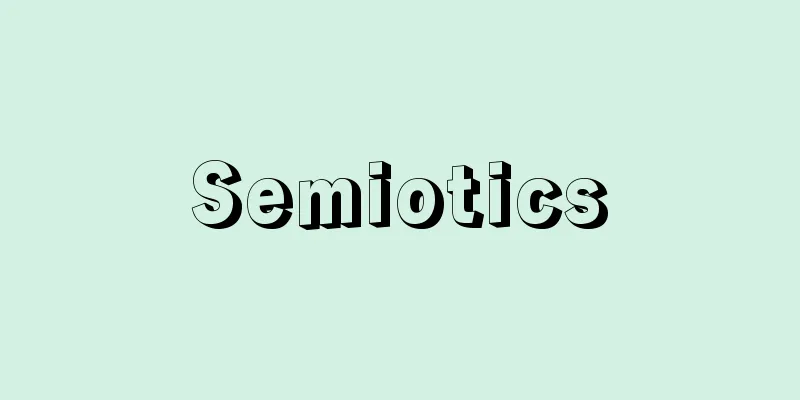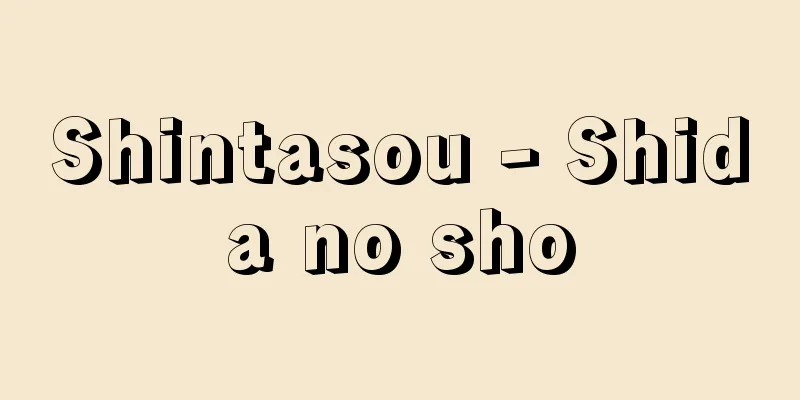Stories about Dojoji Temple

|
A classification term for Japanese theater, dance, and music pieces based on the theme. A general term for pieces that are based on legends or sequels related to the origins of Dojoji Temple in Kishu (Wakayama). (1) Kabuki dance There are many dances based on the Noh play "Dojoji," but the oldest recorded is said to be a performance by Tamagawa Sennojo II during the Enpo era. The first completed dance was the Nagauta "Mugensho Shin Dojoji (Keisei Dojoji)" performed by Segawa Kikunojo I at the Nakamuraza Theater in March 1731 (Kyoho 16), and later, in January 1744 (Enkyo 1), he performed the Nagauta "Hyakuchidori Musume Dojoji" at the Nakamuraza Theater, changing the protagonist from a courtesan to a young woman. After that, Nakamura Tomijuro I performed it at the Nakamura-za in March 1763 (53) and it became an unprecedented hit. Many other pieces were composed, including the Nagauta "Kyokago Musume Dojoji," which has been passed down to this day as the representative piece of Musume Dojoji. In addition, the Nagauta "Kishu Dojoji," composed by Kineya Kangoro III, is the closest form to the original Noh. (2) Joruri: "Dojoji Gendai Hebiurin," which premiered at the Toyotake-za in August 1742 (Kanpo 2), and "Hidakagawa Nyuso Kao," which premiered at the Takemoto-za in February 1769 (59). (3) Jiuta "Kodojoji" Also known as "Katari Dojoji" and "Kanemaki Dojoji." This is a shamisen version of the narration by the waki in the Noh play "Dojoji." It is said that a part of "Dojoji," which was performed on stage by the actor Sakakiyama Koshiro during the Genroku period, remains as a jiuta. The composer was Kishino Jirozo. The koto tegument is said to be by Ichiura Kengyo and Yaezaki Kengyo. (4) Jiuta "Shin Dojoji" The original is said to be a song with the movements of Mizuki Tatsunosuke, and is said to have been composed by Kineya Chogoro II and Yoshizawa Kinshichi, but there have been several adaptations. (5) Jiuta "Kokane ga Misaki" Nakamura Tomijuro I, who danced "Kyokago Musume Dojoji" in Edo, returned to the west and danced "Edo Kane ga Misaki Musume Dojoji" in the Kyogen play "Kyushu Kane ga Misaki" at the Nakayama Bunshichi Theatre in Osaka in 1759, and it is said that this tune was incorporated into the jiuta. The koto tegument in the Kumoi style is also said to be by Fukakusa Kengyo. The lyrics are almost the same as the Nagauta "Kyokago". (6) Jiuta Koto Kyoku "Shin Musume Dojoji" Also called "Shin Kane ga Misaki" in Jiutabu and Yamada school, it is simply called "Kane ga Misaki". The lyrics are almost the same as the first half of the song in (5) above. It has tegoto. It is said to have been composed by Ishikawa Koto of Kyoto in the Tenpo era, or by Kikuoka Kengyo. There are various koto tegoto, including those by Honda Koto, Miyahara Kengyo, and Kuzuhara Koto of Kumamoto in the Meiji era, and there are several types of shamisen replacements. (7) Kato-bushi "Dojoji" A joruri with almost the same plot as the Noh "Dojoji". It was first performed in 1786 or 1787 by Tossumi Kato VI and others. The sangen tegoto is Yamahiko Genshiro II. (8) Itchu-bushi A joruri with almost the same plot as the Noh "Dojoji". There are three versions in the Sugano, Miyako, and Uji schools. Sugano's "Dojoji Bell Memorial Service" was composed by Sugano Satohachi in Bunkyu 1 (1861). Miyako's "Dojoji" was composed by Miyako Issei in Keio 3 (67). Uji's "Dojoji" was composed by Uji Shibunsai 3rd in the mid-Meiji period. (9) Ogie-bushi "Kane no Misaki" The lyrics are the same as (6). Ogie Royu 1st adapted it from a jiuta (a traditional Japanese folk song). (10) Shinnai-bushi "Hidakagawa" An adaptation of the fourth act, "Hidakagawa no Dan," from Gidayu-bushi "Dojoji Gendai Hebirin." It contains humor and is unique among Dojoji-related works. Composed by Tsuruga Wakasa-no-jo 1st. Source: Encyclopaedia Britannica Concise Encyclopedia About Encyclopaedia Britannica Concise Encyclopedia Information |
|
日本の演劇,舞踊,音楽の曲の題材系統による分類用語。紀州 (和歌山) の道成寺の縁起にかかわる伝説あるいはその後日譚を内容とする曲の総称。 (1) 歌舞伎舞踊 能の『道成寺』から舞踊化されたもので多数作られたが,最古の記録は延宝年間の2世玉川千之丞所演のものとされている。舞踊として完成したのは,1世瀬川菊之丞が享保 16 (1731) 年3月,中村座で初演した長唄『無間鐘新道成寺 (傾城道成寺) 』で,のちに寛保4=延享元 (44) 年1月中村座で主人公を傾城から娘に変えた長唄『百千鳥娘道成寺』を上演した。そののち,宝暦3 (53) 年3月中村座で1世中村富十郎が演じて空前の人気を呼び,娘道成寺の代表曲として今日継承された長唄『京鹿子娘道成寺』のほか,多数の曲が作られた。そのほか,原拠の能に最も近い形式のものに,3世杵屋勘五郎作曲の長唄『紀州道成寺』がある。 (2) 浄瑠璃 寛保2 (1742) 年8月豊竹座初演の『道成寺現在蛇鱗』や,宝暦9 (59) 年2月竹本座初演の『日高川入相花王』などがある。 (3) 地歌『古道成寺』 別称『語り道成寺』『鐘巻道成寺』。能『道成寺』のワキによる語りに相当する部分の三味線音楽化。元禄年間に俳優榊山小四郎が舞台で演じた『道成寺』の一部分が地歌として残ったものともいわれる。作曲は岸野次郎三。箏手付は市浦検校のものと八重崎検校のものとある。 (4) 地歌『新道成寺』 原曲は水木辰之助の所作の曲ともいわれ,2世杵屋長五郎,芳沢金七の作曲というが,数種の改編曲もあった。 (5) 地歌『古鐘が岬』 江戸で『京鹿子娘道成寺』を踊った1世中村富十郎が,帰西して宝暦9 (1759) 年に大坂の中山文七座で『九州釣鐘岬 (きゅうしゅうかねがみさき) 』なる狂言のなかで『江戸鹿子娘道成寺』を踊ったが,その曲が地歌に取入れられたものともいう。雲井調子の箏の手付は深草検校ともいう。歌詞は長唄『京鹿子』とほとんど同じ。 (6) 地歌箏曲『新娘道成寺』 『新鐘が岬』ともいい地歌舞や山田流では単に「鐘が岬」と呼ぶ。歌詞は上記 (5) の曲の前半とほぼ同一。手事がある。天保年間京都の石川勾当作曲ともいい,また菊岡検校作曲ともいう。箏の手付にも明治期の熊本の本田勾当のもの,宮原検校のもの,葛原勾当のものといろいろあり,三弦の替手も数種ある。 (7) 河東節『道成寺』 能『道成寺』とほぼ同じ筋の浄瑠璃。天明6 (1786) 年または同7年に6世十寸見河東ほかによって初演。三弦手付2世山彦源四郎。 (8) 一中節 能『道成寺』とほぼ同じ筋の浄瑠璃。菅野派,都派,宇治派の各派に三様の曲がある。菅野の『道成寺鐘供養』は文久1 (1861) 年菅野里八作曲。都の『道成寺』は慶応3 (67) 年都一静作曲。宇治の『道成寺』は明治中期に3世宇治紫文斎作曲。 (9) 荻江節『鐘の岬』 歌詞は (6) と同一。1世荻江露友が地歌から改作。 (10) 新内節『日高川』 義太夫節『道成寺現在蛇鱗』の4段目「日高川の段」の改作。滑稽味を含み,道成寺物としては異色。1世鶴賀若狭掾作曲。
出典 ブリタニカ国際大百科事典 小項目事典ブリタニカ国際大百科事典 小項目事典について 情報 |
>>: The origins of Dojoji Temple
Recommend
Ogo
A brand of bottled water. Medium hard water from t...
Bennettitales
…the name of a group of plants that lived only du...
Ghazna (English spelling)
A city in eastern Afghanistan. Currently called Gh...
Umebachimo (Plum blossom algae) - Umebachimo
…It grows in shallow streams and sometimes in pon...
Food is medicine - Ishokudogen
Both medicines and food are essential for nourishi...
Tadao Shizuki
Born in 1760. Nagasaki [Died] July 9, 1806 (Bunka ...
Kenji Takahashi
Born: August 17, 1871 (Meiji 4) in Sendai [Died] O...
Shikakura
...A place designated for capturing wild birds an...
Geochelone elephantopus
… [Takahiro Matsui]. … *Some of the terminology t...
Morel - Edmund Morel
British railway engineer and foreign employee. Bo...
Wilhelm Meister
Goethe's full-length novel. It consists of Wil...
Onnekotan Island - Onekotanto
A volcanic island in the northern part of the Kur...
Mayama Fruits and Vegetables - Mayama Squid
Playwright, novelist, and historical researcher. ...
Korean brittle star (English name) Amphiura koreae
This echinoderm belongs to the Ophiuroidea family ...
commercial film
…Originally, it meant a TV commercial (commercial...


